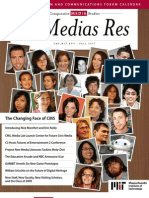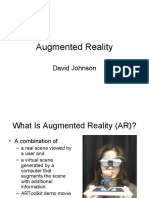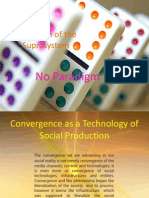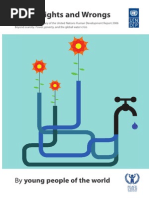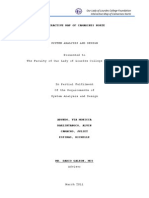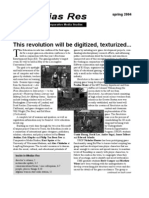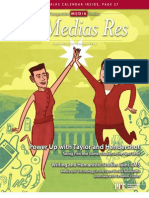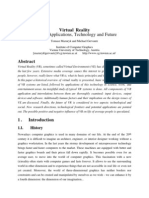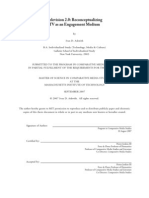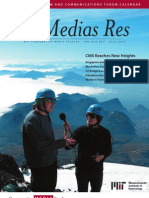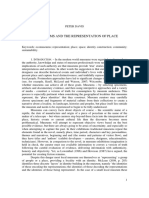3D Hologram Technology PDF
3D Hologram Technology PDF
Uploaded by
Inspirasi KhadijahCopyright:
Available Formats
3D Hologram Technology PDF
3D Hologram Technology PDF
Uploaded by
Inspirasi KhadijahOriginal Title
Copyright
Available Formats
Share this document
Did you find this document useful?
Is this content inappropriate?
Copyright:
Available Formats
3D Hologram Technology PDF
3D Hologram Technology PDF
Uploaded by
Inspirasi KhadijahCopyright:
Available Formats
Proceedings of Informing Science & IT Education Conference (InSITE) 2010
3D Hologram Technology
in Learning Environment
Husain Ghuloum
University of Salford, Department of Built and Human
Environment, Manchester, UK
H.Ghuloum@pgr.salford.ac.uk
Abstract
Major progress has taken place in the field of ICT usage in learning environments. The advantages offered by ICT in this sector have led most educational institutions to integrate ICT services
into their departments. Scientists are working very hard to provide an advanced technology,
which can benefit them in many areas. 3D Hologram Technology (3DHT) is one of the most
creative of these solutions.
In this paper, the researcher presents essential information about 3DHT, in order to understand
the importance of this technology in our life, and in the learning environment in particular. He
also identifies the strengths and weaknesses of 3DHT as a teaching tool, in order to evaluate its
effectiveness as an educational tool.
In order to thoroughly understand the phenomenon, a survey has been carried out on a large sample of teachers in the UK, and therefore the questionnaire has been utilized as a data gathering
technique.
Findings show that, 45.5% of respondents confirmed the importance of 3DHT as an effective
teaching tool for the future. However, 47, 3% of participants mentioned that this technology
could not change the face of education.
Additionally, the results indicate that the main barriers to integrating 3DHT into learning environments are a) the high cost of installation and b) requirement of a high-speed Internet connection.
Keywords: 3D Hologram Technology, Electronic Learning, Electronic Teaching, Learning Environment.
Introduction
In the past, the traditional model of learning is typically characterized as didactic instruction in
which information is presented to students with little consideration of how
Material published as part of this publication, either on-line or
in print, is copyrighted by the Informing Science Institute.
that information is used. Caprio (1994)
Permission to make digital or paper copy of part or all of these
indicated that, in traditional learning, the
works for personal or classroom use is granted without fee
teacher is the sole information giver,
provided that the copies are not made or distributed for profit
undertaking lectures for a large group of
or commercial advantage AND that copies 1) bear this notice
students and the students sitting in the
in full and 2) give the full citation on the first page. It is permissible to abstract these works so long as credit is given. To
classroom are passive recipients of incopy in all other cases or to republish or to post on a server or
formation.
to redistribute to lists requires specific permission and payment
of a fee. Contact 0HPublisher@InformingScience.org to request redistribution permission.
3D Hologram Technology in Learning Environment
The rapid developments in Information Communication Technology (ICT) have made tremendous changes in the many fields of life. Therefore, educational institutions have been quick to
take advantage of technological services via integrating ICT into education, which in turn has
produced new models of education such as e-learning, distance learning and blended learning.
These models have changed the face of learning as well as playing an essential role in the increase of the student population and also providing a good opportunity to learn at any time and/or
place.
Recently, technological developments are playing an important role in improving the educational
process. For example, we see many educational institutions using sophisticated technological
tools such as touch screens, new software and others. However, before using any new tool in education, it must be evaluated to test its ability and effectiveness.
This paper is set in the context of ICT usage in the learning environment. Its key focus is on the
level of effectiveness of 3DHT as a new tool which could support teaching and learning in educational institutions. For that, the paper will be directed at achieving the following objectives as
well as answering the research paper questions.
Research Paper Objectives:
To understand the importance of 3DHT in our lives, and in the teaching and learning environment in particular.
To identify the strengths and weaknesses of 3DHT as a teaching tool.
To identify the barriers which 3DHT faces as a teaching tool.
Research Paper Questions:
Will 3DHT be an efficient tool for teachers in the future?
What difficulties could educational institutions face in engaging with this tool?
The Historical Background of ICT in Education
The technological revolution has contributed to changes in many areas of life. In education, for
example, the famous inventor, Thomas Edison, predicted that textbooks would be replaced by
motion pictures (Mayer, 2005, p.8). Similar predictions were made with the emergence of the
phonograph, radio broadcasting, tape players, TV and video. Despite these attempts were importance in the field of education, many experts argued that these technologies considered as the
mass form of one-way information transfer. For example, public broadcasting prevents individual
learning, because it does not reflect individual needs. The sequential presentations, such as tapes
and videos, do not allow for working with the piece of information actually needed. Therefore
these means can only play a role of supplementary specialised material.
In the 1960s, computers were used in education for computer-assisted instruction. From 1978 to
about 1982, the inclusion of computers in schools was primarily a grass-roots movement, often
led by a single teacher this usually resulted in only one teacher in a building using computers
(Roberts et al, 1988, p. 1). However, not all teachers were enamored of computing. They were not
user-friendly and there were little to no options for application to the curriculum. But some experts confirmed that the computer was the future of learning. According to Setzer:
"Increasingly, the computers of the very near future will be the private property of individuals, and this will gradually return to the individual the power to determine patterns of
education. Education will become more of a private act ... There will be new opportunities for imagination and originality." (Setzer, 1997, p.37)
694
Ghuloum
Sir Tim Berners-Lee, working at the European Laboratory for Particle Physics (CERN) in Geneva, created the World Wide Web (WWW) in 1989. However, the coming of age of the Web in
the educational sector was during 1990s, when Berners-Lee had built all the tools necessary for a
working Web. These tools included the first Web browser, which was also a Web editor, the first
Web server (info.cern.ch), and the first Web pages, which described the project itself. The browser could access Usenet newsgroups and FTP files as well. Almost immediately after Berners-Lee
completed the World Wide Web browser for the NeXT platform, Nicola Pellow created a simple
text browser that could run on almost any computer to encourage use within CERN (Gillies &
Cailliau, 2000). However, Nielsen (1995) confirmed that, the real breakthrough for the Web in
the context of the learning environment was in 1993 when the easy-to-use point and click Web
client Mosaic was released by NCSA (the National Centre for Super computing Applications).
Since then the Web has been growing at an unbelievable speed and has become a system that has
not only completely changed the importance of hypertext and hypermedia but has also had a
strong influence on many fields of computing and information technology as a whole.
Today, the Internet and virtual world support active, hands-on learning which can provide students with practical, real-life experience. According to Sandra Andrews, an educational researcher at Arizona State University College of Education, "The virtual world gives a greater
sense of presence than discussion boards... [so] the students get a better feel for the teacher, and it
is more fun" (Harrison, 2009, p.2). Hence, many studies have shown that this style of learning
results in better retention and understanding of a given topic.
3D Hologram Technology (3DHT)
The word, hologram is composed of the Greek terms, "holos" for "whole view"; and gram meaning "written". A hologram is a three-dimensional record of the positive interference of laser light
waves. A technical term for holography is wave front reconstruction (Universal-Hologram, 2009).
Dennis Gabor, the Hungarian physicist working on advancement research for electron microscopes, discovered the basic technology of holography in 1947. However, the technique was not
fully utilised until the 1960s, when laser technology was perfected. 3D Holographic Technology
(3DHT) created in 1962 by scientists in both the United States and the Soviet Union. However,
3DHT has advanced notably since the 1980s owing to low-cost solid-state lasers that became easily accessible for consumers in devices such as DVD players (Chavis, 2009).
The way 3DHT operates is by creating the illusion of three-dimensional imagery. A light source
is projected onto the surface of an object and scattered. A second light illuminates the object to
create interference between both sources. Essentially, the two light sources interact with each
other and cause diffraction, which appears as a 3D image.
Through the enormous development of technology, many scientists began to make greater use of
3DHT. Indeed, scientists managed transfer of individuals from one place to another without the
need to travel. This sounds like something from a science fiction movie or T.V show. But this
phenomenon has already taken place in American elections in 2008, when Jessica Yellin, in Chicago, was `beamed up` into Wolf Blitzer's studio in New York with a very realistic display (Figure1). This event attracted millions viewers to watch the hologram effect via a YouTube clip. In
fact, "CNN Hologram" was the 22nd most searched term on Google shortly following the coverage (Welch, 2008).
695
3D Hologram Technology in Learning Environment
Figure1: A diagram of the CNN Hologram (Serrao, 2008)
Musion System Company seamlessly integrated their 3D holographic display technology with
Ciscos TelePresences system to create the worlds first real time virtual presentation (Musion
System, 2009). Hence, 3D Holograms have broken out of the world of science fiction and fantasy
and are about to become common currency between many countries around the world. Live and
life-size 3D TelePresence holograms can now interact with their remote audiences whether they
are a band performing on stage, a politician delivering a keynote speech, or a CEO holding an
interactive meeting with colleagues around the world.
The Importance of 3DHT
We can see the importance of 3DHT in many areas, such as marketing and advertising, society,
environment and education.
The Importance of 3DHT on marketing and advertising:
3DHT clearly has a powerful future. James (2009) pointed out that, As this audiovisual display
continues to get high profile credibility, we are likely to see more companies advertising their
products or marketing business in this way". As examples of marketing using 3D holograms, we
could mention Lexus in NYC in 2005, fashion designers like Alexander McQueen and his holographic Kate Moss advertisement in 2006 or Diesel in 2007 (Adverblog, 2008). In July 2009,
marketing statistics show that using 3DHT contributed significantly to increasing the number of
the UK customers (Emarketer, 2009).
The importance of 3DHT on society
The importance of 3DHT on the society lies in the interdependence of human relations. For instance, the Pentagon wants to create computerized hologram-like moms and dads that can talk
with the kids when their parents are deployed far from home. Navy commander Russell Shilling,
the experimental psychologist overseeing the program, said a child may get a response from saying 'I love you,' or 'I miss you' or 'Good night`... the goal: reassuring little ones whose parent has
suddenly disappeared" (Thompson, 2009). Another example on this issue is the virtual assistant.
For instance, the virtual holographic assistant can help you to prepare a meal in the kitchen, or
stand beside you and talk about different topics. Although this may sound like pure fiction, there
is reason to believe that it could become reality in just a few years time.
The importance of 3DHT on the environment
The importance of 3DHT on the environment lies in reducing the air pollution caused by aircraft,
which burn hydrocarbon fuels, something which is considered one of main reasons for global
696
Ghuloum
warming. Prince Charles confirmed this fact in a green energy conference in Abu Dhabi, as
shown in Figure2. He was keen to prove his green credentials by noting that if he had chosen to
appear in person, his long-haul flight would have emitted around 15 tons of carbon dioxide, the
greenhouse gas which is causing global warming. Hence, he appeared as a hologram to congratulate Abu Dhabi for its plans to harness the power of natural resources to create a new zero carbon
city called "Masdar". As the 3DHT, Prince Charles left the audience with the words: "I am now
going to vanish into thin air, leaving not a carbon footprint behind!" (Jacob, 2008, p.2).
Trewin Restorick, of the energy saving charity Global Action Plan, told Sky News: "It's been estimated it contributes to 3.5% of the world's green house gases we're pumping into the atmosphere so businesses need to follow Prince Charles' example" (Jacob, 2008).
Figure 2: Prince Charles appear in Abu Dhabi as a hologram (Mail News, 2007)
The importance of 3DHT on education
In this area we can take advantage of 3DHT in different forms. For example, holograms now allow students to be taught by a "virtual teacher" who could be many kilometers away. The process
goes a step beyond video conferencing in that the hologram teacher appears to be in the classroom, and can see and speak to the pupils as if they were all in the same room. The system used
by Edex, the largest supplier of Internet connections to the UK education market, at the
BETT2000 educational technology show in London (BBC News, 2000). Moreover, 3DHT can
enhance the educational process by bringing famous characters to life again from the past, and
they speak about themselves and/or explain something as an assistant teacher. For instance, there
have certainly been many worthy philosophers and learned men in world history perhaps none
more celebrated that the Greek Philosopher Plato. Unfortunately we are unable to talk with Plato
as he is from a past period, while we are in the present period moving into the future period by
hologram. In Seoul's Alive Gallery Project, holograms and 3-D animation technology bring 62
world-renowned masterpieces of Western art to life again. In this project we can see the Mona
Lisa answering questions from students, such as "Why don't you have any eyebrows?" she is answering, "When I was alive, a woman who had big forehead was considered a beauty so most
women had their eyebrows taken off for beauty". Or, Michelangelo explains the fresco technique
he is using to paint "The Last Judgment". He explains the work of another masterpiece he had
completed earlier on the ceiling of the Sistine Chapel. A pop-up screen shows a close-up of the
famous "Creation of Adam" (Cho, 2008, p.1).
However, 3DHT, as does any technology, has some disadvantages. Firstly, there is the problem of
price. Secondly, 3DHT needs to be connected to a fast Internet, next-generation broadband Inter-
697
3D Hologram Technology in Learning Environment
net network with a minimum guaranteed constant speed of 20 megabits per second. Finally, to
use this technology perfectly, we will need a screening room with compatible lighting and video
technology, which costs around 150,000 US dollars to install, as well as a display screen for
viewing the holograms on, priced at around 215,000 US dollars (Bobolicu, 2009).
Nevertheless, Ian O'Connell, director of Musion, a company that is pioneering the use of live hologram technology, believes that this sort of fixture will be a mainstay in many sectors in the future, perhaps even within the next five years. Its going to necessitate a change in architectural
design for residential homes for it to be embraced fully, he said. Its going to need a room that
can accommodate the screening and delivery technology. But I think were five years away from
holograms being a ubiquitous, affordable tool (Bobolicu, 2009, p.2).
The Methodology and Data Analysis
Data Collection Methods
Hurt (2005) states that the survey is often used to describe frequencies of behaviours and attitudes
and sometimes to recognize relationships between variables, correlations which we want to emphasis on. Hence, on order to answer the paper questions as well as achieving the objectives, a
survey has been carried out on a large sample of teachers in the UK, and therefore the questionnaire has been utilized as a data gathering technique. According to Oates (2006, p.219) the questionnaire is a set of pre-defined questions to be answered by a number of respondents in order to
provide specific data. Hence, a questionnaire was distributed to 400 teachers working in various
levels of education in the UK, thus constituting a random sample (Figure3).
Stage of educaType of institution
Year/grade
tion
key
Higher and fur- Further education Higher education institutions
ther education institutions
(further education (universities and other
colleges, tertiary higher education institucolleges, special- tions)
ist colleges, and
adult education
centres)
Further education School sixth forms or
institutions
sixth form colleges
Upper secondary
Year 11
education
(Y11)
Secondary schools
Lower secondary
education
Primary education
Primary schools
Reception
classes
Typical age
Study sample
18 +
100 lecturers
17 - 18
16 - 17
15 - 16
Y10
Y9
Y8
Y7
Y6
Y5
Y4
Y3
Y2
Y1
14 - 15
13 - 14
12 - 13
11 - 12
10 - 11
9 - 10
8-9
7-8
6-7
5-6
4-5
100 teachers
100 teachers
100 teachers
Figure 3: The Study Sample (Diagram of the Education system in England and Wales, 2009)
698
Ghuloum
In order to maximize validity by standardizing the sample, the researcher explained the purpose
of the study and gave an introduction to the 3DHT of all respondents to know what the meaning
of this technology. Moreover, he clarified concisely all questions of the questionnaire before each
teacher and lecturer started filling it out. The researcher carried out follow-ups with the participants according to what participants identified as areas in which they needed help and once
teachers complete the questionnaires, the researcher has collected them straight away.
Each question in the questionnaire has been evaluated by using a pilot study or must be pilot
tested before the final administration. This procedure is vital for any questionnaire in order to
evaluate how respondents interpret the question's meaning and also to check if the range of response alternatives is sufficient. Furthermore, it is also important to evaluate how to phrase each
question, layout, check the wording in the questions to avoid potential confusion (De Vaus,
2002). The pilot study suggested that the questionnaires appeared to be an effective method of
collecting a large amount of relatively basic information in a short space of time.
Data Analysis and Findings
The survey was conducted during the period of the 4th to 31st of October 2009. The researcher
sent out the questionnaires to the 400 teachers who were chosen randomly from different levels of
education in the UK. All questionnaires were returned, this meaning all the population had participated (Table 1).
Table 1: The response of questionnaire
Response rate
Population
Research
Sample
Response
Category
Instrument
Size
No.
Teachers
Questionnaire
400
400
100
First of all, the researcher wants to know the relationship between the teachers from different levels of education and their thoughts on whether 3DHT will enhance learning (Table 2). The table
shows that, 228 (57%) of respondents said Yes, whereas 61 (15.3%) said No. While, 111
(27.8%) said Dont know. These proportions clarified that there is a large percentage of respondents believe that, the hologram technology will support the learning process. However, if we
break down their responses by educational phase, we will find different views. For instance, 46
teachers in primary stage said "yes", whereas just 2 said "no" and 51 said "don't know". That is
the stage with the highest percentage of teachers who are not sure if this technology will enhance
the educational process or not. On the other hand, the situation was different in other stages of
education because most of the teachers especially in higher education (73 teachers) emphasized
the importance of the hologram in supporting the educational process.
699
3D Hologram Technology in Learning Environment
Table 2: Relationship between the 3DHT and enhance learning
Table 2
Do you think the
3DHT will enhance the learning?
Primary educa-
Lower secon-
Upper secon-
Higher and fur-
tion
dary education
dary education
ther education
Total
Yes
47
56
52
73
228
No
19
31
61
51
25
17
18
111
100
100
100
100
400
Don't know
Total
Table 3 clarifies the relationship between the teachers and their thoughts on whether 3DHT will
change the face of learning. The table shows that, 92 (23%) of respondents said Yes, whereas
189 (47,3%) said No. While, 119 (29.8%) said Dont know. These ratios indicate that there is
a large percentage of respondents who believe that hologram technology will not change the face
of education, especially in primary education.
Table 3: Relationship between the 3DHT and change the face of learning
Table 3
Do you think the
3DHT will change
the face of learning?
Total
Primary educa-
Lower secon-
Upper secon-
Higher and fur-
tion
dary education
dary education
ther education
Total
Yes
16
17
21
38
92
No
63
57
42
27
189
Don't know
21
26
37
35
119
100
100
100
100
400
In table 4, the researcher wants to explore the relationship between teachers from different stages
of education and their thoughts on whether 3DHT will be a tool for the teacher. The table shows
that 243 (60.8%) of respondents said Yes, whereas 59 (14.8%) said No and 98 (24.5%) said
Dont know. According to these percentages, there is a large ratio of respondents who believe
that hologram technology will be a tool for the teacher. However, if we analyse this question in
each educational phase, we will find 77 teachers in higher education stage said "yes". That is
mean hologram technology could be a future tool for teachers in the phase of higher education in
many majors.
700
Ghuloum
Table 4: Does the 3DHT will be a tool of teacher?
Table 4
Primary educa-
Lower secon-
tion
dary education
Do you think the Yes
3DHT will be a
tool of teacher?
Upper secondary Higher and fureducation
ther education
Total
46
57
63
77
243
No
21
19
11
59
Don't know
33
24
26
15
98
100
100
100
100
400
Total
Table 5 shows the relationship between the teachers and their thoughts on whether 3DHT would
be an effective teaching tool in the future. The ratios show that 182 (45.5%) of respondents said
Yes, whereas 63 (15.8%) said Noand 155 (38.8%) said Dont know. Overall, the percentages emphasise the perceived importance of the hologram as an effective teaching tool in the future. However, both teachers in primary schools and lower secondary schools were not sure if this
technology will be an efficient instrument for teaching in the future or not. However, teachers in
upper secondary schools and higher education asserted the importance of the 3DHT as an effective tool for the teacher in the future.
Table 5: Does the 3DHT will be an effective teaching tool in the future?
Table 5
Do you think
the Hologram
will be an effective teaching
tool in the fu-
Primary educa-
Lower secon-
tion
dary education
Upper secondary Higher and fureducation
Total
ther education
Yes
31
43
47
61
182
No
26
13
15
63
Don't know
43
44
38
30
155
100
100
100
100
400
ture?
Total
Table 6 seeks to identify the obstacles that may face the integration of holograms into the learning
environment. This table shows that 380 (95%) of all participants confirmed that the main barriers
that could hinder integrate of the 3DHT into education is the high cost of installation, whereas
315 (78.8%) of all teachers in different stages said that 3DHT needs high speed Internet and
that could be an obstacle. 41 (10.3%) of all respondents mentioned that, it is not easy to use the
hologram technology in a learning environment while 77 (19.3%) of all participants indicated that
there are other reasons which could prevent the merger of the hologram into education. For
instance, most of them don't like to deal with this technology, because it is vulnerable to interruption at any moment which may disrupt the smooth flow of the learning process.
701
3D Hologram Technology in Learning Environment
Table 6: Possible barriers which 3DHT when integration into the learning environment
What are possible obstacles that
holograms may face in terms of
integration into the learning
environment?
Table 3.6
Included
N
Excluded
Percent
Total
Percent
Percent
It needs high cost of installation
380
95%
20
5%
400
100.0%
It needs high speed Internet
315
78.8%
85
21.3%
400
100.0%
41
10.3%
359
89.8%
400
100.0%
77
19.3%
323
80.8%
400
100.0%
It is difficult to use
Other
Overall, the results showed some interesting points related to the use of 3DHT as a teaching tool as well as the reasons that hinder its integration into the UK learning environment. For example, the majority of respondents confirmed that 3DHT reinforces the
learning process, as well as potentially being an effective teaching tool for the future.
However, most participants mentioned that this technology does not change the face of
education. Moreover, the main barriers that may hinder the integration of 3DHT into the
learning environment are the high cost of installation and requirement of a high-speed
Internet connection.
Conclusion
Teachers replaced by holograms. It sounds like something from a science fiction movie or T.V
show. What would happen if holographic teachers could be sent to you? The reality is the technology has recently been created to bring live holograms from one location and beam them into
any location in the world.
This phenomenon led the researcher to investigate whether 3DHT will be an effective tool for the
teachers in the future. Furthermore, the researchers wished o explore the main barriers that might
prevent 3DHT being integrated into a learning environment. In order to move towards an answer
in this issue, the researcher posed the following questions;
1.
Will 3DHT be an efficient tool for teachers in the future?
The researcher noted that, 60.8% of respondents have confirmed the importance of 3DHT as an
efficient tool for teachers while 45.5% believed that 3DHT will be an effective teaching tool for
the future. However, 47.3% of teacher in all stages mentioned that this technology could not
change the face of education, but it could help them to some extent in their teaching.
2.
What are the difficulties, which educational institutions could face in engaging
with this tool?
According to the study findings, the main barriers that may hinder the integration of 3DHT into
learning environments are needing a high cost of installation and needing high speed Internet.
Although 95% of all participants indicated that 3DHT is very expensive and difficult to integrate
it with the learning environment, the researcher believes that it is very interesting to use this technology in the teaching process even if it is very expensive to implement at present.
702
Ghuloum
References
Adverblog. (2008). Hologram of French goalkeeper by Adidas. Retrieved November 11, 2009, from
http://www.aderblog.com/archives/oo3655.htm
BBC News. (2000, January 13). Meet the hologram teacher. BBC News. Retrieved November 21, 2009
http://news.bbc.co.uk/1/hi/in_depth/education/2000/bett2000/600667.stm
Bobolicu, G. (2009). Live hologram communication to become reality within five years. Retrieved October 25, 2009, from http://gadgets.softpedia.com/news/Live-Hologram-Communication-to-BecomeReality-within-5-Years-1233-01.html
Caprio, W. (1994). Easing into constructivism: connecting meaningful learning with student experience.
Journal of College Science Teaching, 23(4), 210-212.
Chavis, J. (2009). 3D holographic technology. Retrieved October 17, 2009, from
http://www.ehow.co.uk/about_5448579_holographic-technology.html
Cho, J. (2008, June 13). Talking to Mona Lisa & Michelangelo. ABC News. Retrieved October 19, 2009,
from http://abcnews.go.com/International/Travel/story?id=5060941&page=1
De Vaus, D. (2002). Surveys in social research (5th ed.). London: Routledge Publications
E-Marketer. (2009). UK online advertising: Spending and trends. Retrieved November 14, 2009, from
http://www.marketresearch.com/vendors/sampleviewer/default.asp?SID=74063740-471111915410945431&VendorID=1282.
Gillies, J., & Cailliau, R. (2000). How the web was born: The story of the world wide web. Oxford: University Press.
Harrison, D. (2009, Febuary 18) Real-Life teaching in a virtual world. Campus Technology. Retrieved February 14, 20101, from
http://www.marketresearch.com/vendors/sampleviewer/default.asp?SID=74063740-471111915410945431&VendorID=1282
Hurt, C. (2005). Doing your masters dissertation: Realizing your potential as a social scientist. London:
Sage.
Jacob, C. (2008, April 7). Prince Charles delivers virtual speech as hologram. Sky News. Retrieved October
21, 2009, from http://news.sky.com/skynews/Home/Sky-News-Archive/Article/20080641301500
James, R. (2009). 3D holographic projection - The future of advertising. Retrieved November 10, 2009,
from http://www.articlecity.com/articles/gadgets_and_gizmos/article_1509.shtml
Mail Online. (2007, December 13). Prince Charles will appear at conference as a hologram. Mail News.
Retrieved February 12, 2010, from
http://www.telepresenceoptions.com/2008/11/holographic_presenters_jessica/
Mayer, R. E. (2005). The Cambridge handbook of multimedia learning. Cambridge University Press, p.8.
Musion System. (2009). Musion on-stage holographic telepresence. Retrieved October 21, 2009, from
http://www.musion.co.uk/musion_telepresence.html
Nielsen, J. (1995). Multimedia and hypertext: The internet and beyond. Boston: Morgan Kaufmann.
Oates, B. J. (2006) Researching information systems and computing. London: Sage Publications.
Roberts, N., Carter, R. C., Friel, S. N., & Miller, M.S. (1988). Integrating computers into the elementary
and middle school. Englewood Cliffs, NJ: Prentice Hall.
Serrao, J. (2008, November 6). Holobama: 'Holograms' greet election 2008. Teleprence Options News. Retrieved February 10, 2010, from
http://www.telepresenceoptions.com/2008/11/holographic_presenters_jessica/
Setzer, V.W. (1997). Computers as instruments of counter-art. 8th Brazilian Conference on Computers in
Education, Brazilian Computer Society, 6-9 November.
703
3D Hologram Technology in Learning Environment
Thompson, M. (2009, January 9). When daddy is off at war: A hologram home? The Time.
Universal-Hologram. (2009). What is holography? and, How to light a hologram. Retrieved October 17,
2009, from http://universalhologram.com/what_is_holography.htm
Welch, C. (2008, November 6). Beam me up, wolf! CNN debuts election-night 'hologram'. CNN News. Retrieved October 19, 2009, from http://www.cnn.com/2008/TECH/11/06/hologram.yellin/index.html
Biography
Husain Ghuloum is a researcher in Information Systems at Salford
University. He worked lecturer at the Public Authority for Applied and
Education (PAAET) in the State of Kuwait for around four years ago.
Ghuloum got Master Information Science at Leeds Metropolitan University and currently working on research relating to ICT in Kuwaiti
Higher Education at Salford University.
704
You might also like
- Fabric Formwork Book Methods For Building New Architectural and Structural Forms in ConcreteDocument602 pagesFabric Formwork Book Methods For Building New Architectural and Structural Forms in Concretemypham.vnNo ratings yet
- Create Web Parallax EffectsDocument6 pagesCreate Web Parallax EffectsRohanNo ratings yet
- In Media Res, Fall 2007Document36 pagesIn Media Res, Fall 2007MIT Comparative Media Studies/WritingNo ratings yet
- Opticalillusion 110627074058 Phpapp01Document27 pagesOpticalillusion 110627074058 Phpapp01Dasuni Weerarathne100% (1)
- Augmented RealityDocument8 pagesAugmented Realitydthornburg5543No ratings yet
- Vogler Space ArchitectureDocument10 pagesVogler Space ArchitecturemareNo ratings yet
- Andrea Kim, "Virtual Worldmaking: A Phantasmal Media Approach To VRChat"Document106 pagesAndrea Kim, "Virtual Worldmaking: A Phantasmal Media Approach To VRChat"MIT Comparative Media Studies/WritingNo ratings yet
- Perception: Principles of Architecture - Ii (Ar-108 C)Document44 pagesPerception: Principles of Architecture - Ii (Ar-108 C)ABHINAV SEHGALNo ratings yet
- MapStory and The Digital HumanitiesDocument5 pagesMapStory and The Digital HumanitiesMapStoryNo ratings yet
- The Immersive Internet: Make Tactical Moves Today For Strategic Advantage TomorrowDocument22 pagesThe Immersive Internet: Make Tactical Moves Today For Strategic Advantage TomorrowRussell W. RobbinsNo ratings yet
- VR The World Experimenting With Emotion and PresenceDocument12 pagesVR The World Experimenting With Emotion and PresenceTrang MarbleNo ratings yet
- Where Is The Voice Without Its Body? A Virtual Quest Into Musical EmbodimentDocument13 pagesWhere Is The Voice Without Its Body? A Virtual Quest Into Musical EmbodimentMichelle OosthuyzenNo ratings yet
- Augmented Reality: David JohnsonDocument26 pagesAugmented Reality: David JohnsonPranay Rawat100% (1)
- Immersive MultimediaDocument8 pagesImmersive Multimediaنور روسلنNo ratings yet
- ParallaxDocument26 pagesParallaxMaria Sri PangestutiNo ratings yet
- Slater and Wilbur - A Framework For Immersive Virtual Environments (FIVE) 1997Document20 pagesSlater and Wilbur - A Framework For Immersive Virtual Environments (FIVE) 1997Karl MickeiNo ratings yet
- Virtual Reality: CS 620 - Human Computer InteractionDocument50 pagesVirtual Reality: CS 620 - Human Computer InteractionpradnyakaspateNo ratings yet
- Violence of The Virtual and Integral RealityDocument13 pagesViolence of The Virtual and Integral RealityΒασίλης ΣίνοςNo ratings yet
- Uv Mapping TutorialDocument5 pagesUv Mapping Tutorialbkb193No ratings yet
- Immersive Multimedia: CelcomDocument8 pagesImmersive Multimedia: CelcomAzymaNo ratings yet
- 3D Holograph Projection Future of Visual CommunicationDocument4 pages3D Holograph Projection Future of Visual CommunicationUnni KsNo ratings yet
- Psychotechnologies: Interfaces of Language, Media and MindDocument11 pagesPsychotechnologies: Interfaces of Language, Media and MindJaime Coello ManuellNo ratings yet
- Military Industrial Complex Withholds ZeroDocument6 pagesMilitary Industrial Complex Withholds ZeroAkshaya Kumar RathNo ratings yet
- Sfm-Net: Learning of Structure and Motion From Video: Sudheendra Vijayanarasimhan Susanna Ricco Cordelia SchmidDocument9 pagesSfm-Net: Learning of Structure and Motion From Video: Sudheendra Vijayanarasimhan Susanna Ricco Cordelia SchmidMalik Hashmat100% (1)
- The Dawn of The SupraSystemDocument21 pagesThe Dawn of The SupraSystemAna SoricNo ratings yet
- Water Rights and Wrongs EnglishDocument32 pagesWater Rights and Wrongs EnglishS V S VardhanNo ratings yet
- Mixed Reality PDFDocument8 pagesMixed Reality PDFatom tuxNo ratings yet
- The Metainterface Part 1 PDFDocument43 pagesThe Metainterface Part 1 PDFPedro MaiaNo ratings yet
- Agent Intellects: Pattern As A Form of ThoughtDocument8 pagesAgent Intellects: Pattern As A Form of ThoughtEd KellerNo ratings yet
- System Analysis and Design: Interactive Map of Camarines NorteDocument49 pagesSystem Analysis and Design: Interactive Map of Camarines NorteEmz Shee Padul CabugaNo ratings yet
- In Medias Res, Spring 2004Document12 pagesIn Medias Res, Spring 2004MIT Comparative Media Studies/WritingNo ratings yet
- Tele Immersion DocumentationDocument16 pagesTele Immersion Documentationnaveenjawalkar0% (1)
- Room Racers: Design and Evaluation of A Mixed Reality Game PrototypeDocument7 pagesRoom Racers: Design and Evaluation of A Mixed Reality Game Prototypeatom tuxNo ratings yet
- In Medias Res, Fall 2005Document12 pagesIn Medias Res, Fall 2005MIT Comparative Media Studies/WritingNo ratings yet
- Invisible SeminarDocument33 pagesInvisible SeminarLeoNo ratings yet
- Hologram Engineering Projector DrawingsDocument31 pagesHologram Engineering Projector Drawingsapi-42295168667% (3)
- Computer Games As Participatory Media CultureDocument18 pagesComputer Games As Participatory Media CultureEvelineRoelsNo ratings yet
- Marius Watz - All Your Vectors Are Belong To UsDocument2 pagesMarius Watz - All Your Vectors Are Belong To UsMarius Watz100% (1)
- Improvement of User Experience Using Virtual Reality in Open-Architecture Product DesignDocument12 pagesImprovement of User Experience Using Virtual Reality in Open-Architecture Product DesignJonas AssisNo ratings yet
- Kristina Drzaic, "Oh No I'm Toast!: Mastering Videogame Secrets in Theory and Practice"Document86 pagesKristina Drzaic, "Oh No I'm Toast!: Mastering Videogame Secrets in Theory and Practice"MIT Comparative Media Studies/Writing100% (1)
- From Cinema To Virtual Reality. A Phenomenological Approach To The Experience of Immersive DocumentariesDocument68 pagesFrom Cinema To Virtual Reality. A Phenomenological Approach To The Experience of Immersive DocumentariesManuel BarrionuevoNo ratings yet
- Skin of Culture, Derrick de KerckhoveDocument80 pagesSkin of Culture, Derrick de KerckhoveMatilde MammanaNo ratings yet
- Applied Optics AssignmentDocument17 pagesApplied Optics Assignmentbhumika choudharyNo ratings yet
- Dourish 1999Document16 pagesDourish 1999Soonwook ChoiNo ratings yet
- Digital NativeDocument5 pagesDigital NativeGeorgiana MadalinaNo ratings yet
- In Media Res, Spring 2013Document32 pagesIn Media Res, Spring 2013MIT Comparative Media Studies/WritingNo ratings yet
- Virtual Reality1Document72 pagesVirtual Reality1vinni vone100% (4)
- Ivan Askwith, "Television 2.0: Reconceptualizing TV As An Engagement Medium"Document174 pagesIvan Askwith, "Television 2.0: Reconceptualizing TV As An Engagement Medium"MIT Comparative Media Studies/Writing100% (3)
- Cultural AssaultDocument15 pagesCultural AssaultfarooqNo ratings yet
- In Media Res, Fall 2006Document24 pagesIn Media Res, Fall 2006MIT Comparative Media Studies/WritingNo ratings yet
- Timothy Mitchell: It Came From Inner Space: Faith, Science, Conquest and The War of The WorldsDocument110 pagesTimothy Mitchell: It Came From Inner Space: Faith, Science, Conquest and The War of The WorldsterrythecensorNo ratings yet
- In Medias Res, Spring 2015Document24 pagesIn Medias Res, Spring 2015MIT Comparative Media Studies/WritingNo ratings yet
- 3D Holographic Projection TechniqueDocument26 pages3D Holographic Projection TechniqueGagan Shrivastava0% (1)
- Gps in Surveying PDFDocument3 pagesGps in Surveying PDFJaiNo ratings yet
- Peter Davis ECOMUSEUMS AND THE REPRESENTATION OF PLACEDocument15 pagesPeter Davis ECOMUSEUMS AND THE REPRESENTATION OF PLACElibertinoula100% (1)
- Research Through Design As A Method For Interaction Design ResearDocument11 pagesResearch Through Design As A Method For Interaction Design ResearClaudia Alvarado100% (1)
- Beyond the Horizon: A Comprehensive Guide to Astronomy and the UniverseFrom EverandBeyond the Horizon: A Comprehensive Guide to Astronomy and the UniverseNo ratings yet
- Brochure Evolve DatasheetDocument3 pagesBrochure Evolve DatasheetAhmed GhufranNo ratings yet
- Mars Buys Ecuador Cocoa Farm Hacienda La CholaDocument3 pagesMars Buys Ecuador Cocoa Farm Hacienda La CholaOscar N.No ratings yet
- C4 Strategic ManagementDocument5 pagesC4 Strategic ManagementAdnan ZiaNo ratings yet
- Amity University: Amity Institute of Information Technology, RanchiDocument2 pagesAmity University: Amity Institute of Information Technology, RanchipraveenNo ratings yet
- I Believe in You and MeDocument8 pagesI Believe in You and Mea478458188No ratings yet
- Review On Wave PropagationDocument34 pagesReview On Wave PropagationEnglish 207No ratings yet
- Tech 8Document4 pagesTech 8Anum Zara (Zaari)No ratings yet
- Maternity Waiting HomesDocument2 pagesMaternity Waiting HomesRicky BustosNo ratings yet
- Edu 365 Colombian Culture BrochureDocument2 pagesEdu 365 Colombian Culture Brochureapi-251069371No ratings yet
- ArrestDocument182 pagesArrestELEAZAR CALLANTANo ratings yet
- Reveries of The Solitary Walker, RousseauDocument11 pagesReveries of The Solitary Walker, RousseauRachel AHNo ratings yet
- Classification of Bus BarDocument6 pagesClassification of Bus BarVikas SinghNo ratings yet
- P2000 PCM30MD User Guide V1-1Document11 pagesP2000 PCM30MD User Guide V1-1Talhante MasterNo ratings yet
- C:/Users/Rafe/Appdata/Local/Programs/Python/Python35-32/Scripts Object and Data Structures BasicsDocument16 pagesC:/Users/Rafe/Appdata/Local/Programs/Python/Python35-32/Scripts Object and Data Structures BasicsrafeNo ratings yet
- FortiSwitchDocument2 pagesFortiSwitchjosedasdbidNo ratings yet
- 2.2.6 Types of NBFCsDocument9 pages2.2.6 Types of NBFCsnk6730621No ratings yet
- Atm WorkingDocument4 pagesAtm WorkingKarthigaiselvan ShanmuganathanNo ratings yet
- Biography of A Song Not A Day Goes byDocument8 pagesBiography of A Song Not A Day Goes byColm MolloyNo ratings yet
- Online Exam - Microbiology Part 6Document33 pagesOnline Exam - Microbiology Part 6qnx6696m7fNo ratings yet
- Donatello and Ghiberti, The Choice Between Compositional Unity and Narrative ForceDocument6 pagesDonatello and Ghiberti, The Choice Between Compositional Unity and Narrative ForceJosé Luis MartínNo ratings yet
- Substance Misuse Disorders: Dr. Ravi PaulDocument19 pagesSubstance Misuse Disorders: Dr. Ravi PaulRavi PaulNo ratings yet
- 62 People V Hadji Soccor CadidiaDocument3 pages62 People V Hadji Soccor CadidiaKristel Hipolito100% (1)
- Lecture 3-Conveying and DistributingDocument61 pagesLecture 3-Conveying and DistributingCamila Miranda KandaNo ratings yet
- Organisational Behaviour 1 PDFDocument9 pagesOrganisational Behaviour 1 PDFJasonSpring100% (1)
- OrganizingDocument36 pagesOrganizingjazcarraga87No ratings yet
- Module--1---Complex-Analysis-pptxDocument61 pagesModule--1---Complex-Analysis-pptxyuvrajm.21.becvNo ratings yet
- Product Resume-Ziad AbdelmgeedDocument2 pagesProduct Resume-Ziad AbdelmgeedZiad AbdelmgeedNo ratings yet
- SHIELD ActDocument4 pagesSHIELD ActDziennik InternautówNo ratings yet
- Yi-Cheng Wu DKK (2014) Light Intensity Affects The Performance of Photo Microbial Fuel Cells With Desmodesmus Sp. A8 As Cathodic MicroorganismDocument5 pagesYi-Cheng Wu DKK (2014) Light Intensity Affects The Performance of Photo Microbial Fuel Cells With Desmodesmus Sp. A8 As Cathodic MicroorganismTiara MaharaniNo ratings yet
- Music in FilmsDocument44 pagesMusic in FilmsprzegorzgotockiNo ratings yet


